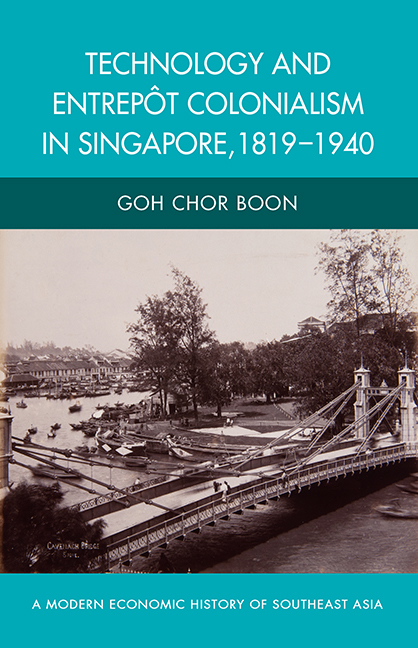Book contents
- Frontmatter
- Contents
- List of Figures and Tables
- Notes on Currency
- Introduction
- 1 Technology and the British Empire
- 2 Pioneers of Change: Entrepreneurs and Engineers
- 3 Maritime Technology and Development of the Port
- 4 Introducing Technological Systems
- 5 Sanitation and Public Health
- 6 Agriculture and Colonial Science
- 7 Food and Singapore Cold Storage
- 8 Politics of Imperial Education
- 9 Technology Transfer and Limited Industrial Growth
- Conclusion
- Bibliography
- Index
9 - Technology Transfer and Limited Industrial Growth
Published online by Cambridge University Press: 21 October 2015
- Frontmatter
- Contents
- List of Figures and Tables
- Notes on Currency
- Introduction
- 1 Technology and the British Empire
- 2 Pioneers of Change: Entrepreneurs and Engineers
- 3 Maritime Technology and Development of the Port
- 4 Introducing Technological Systems
- 5 Sanitation and Public Health
- 6 Agriculture and Colonial Science
- 7 Food and Singapore Cold Storage
- 8 Politics of Imperial Education
- 9 Technology Transfer and Limited Industrial Growth
- Conclusion
- Bibliography
- Index
Summary
By 1914, Britain ceased to be the only industrialized nation. The era of the “imperialism of free trade” had ended. The British government was increasingly concerned with the need to review and deploy the Empire's “underdeveloped estates”, in Joseph Chamberlain's phrase, to support its domestic economy. Dependent colonies throughout the British Empire, however, were not encouraged to produce goods which could compete against imports coming directly from the industrial heartlands of Britain. As suggested by Kemp and Headrick, so long foreign rule continues, colonial societies, including those that were developed solely as trading city-ports (such as Singapore), have generally failed to generate a favourable environment for industrialization to take place. And even if some form of industrialization does take place, it is usually regarded as “peripheral” that is, industries that are largely dependent on imported technologies and supported by an abundant supply of cheap labour force, most of whom are women and children. Technology transfers which might have led to the growth of import-substitution industries were generally discouraged because not only they would have competed with British manufacturers, but they motivated the rise of native industrialists and cadres of engineers and technicians. Technology transfer, either in the form of a new process or piece of machinery, was introduced into a colony together with European experts who would zealously guard their knowledge and skills.
As Britain's major trading emporium in Southeast Asia, Singapore “was in no way an industrial city [and] at the end of the 1930s, first-stage import-substitution, involving a replacement of non-durable consumer goods, remained incomplete”. Industrial growth was linked to primary commodity exports and the rubber industry was the key contributor. Its role in the international trading system was that of a transshipment centre, just like Hong Kong which was used by British companies as the springboard to exploit the promising China market after 1842. Strategically situated, “[t]he colonial economy of Singapore and Malaya developed as part of what has been called the Old International Division of Labour (OIDL) in which the countries of the southern hemisphere exported primary products to the industrializing countries of the northern hemisphere which requited these with a return flow principally of manufactured goods”.
- Type
- Chapter
- Information
- Technology and Entrepot Colonialism in Singapore, 1819–1940 , pp. 221 - 239Publisher: ISEAS–Yusof Ishak InstitutePrint publication year: 2013



